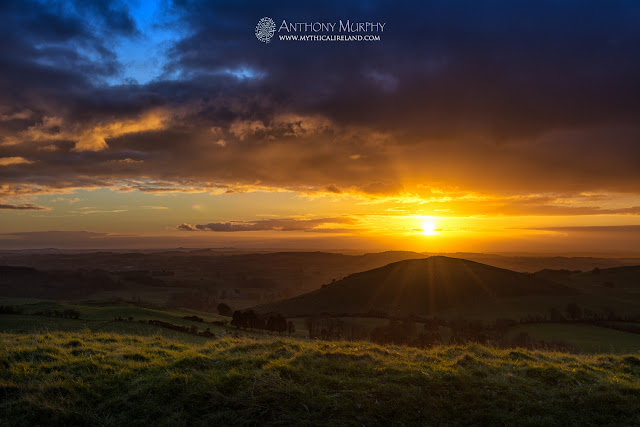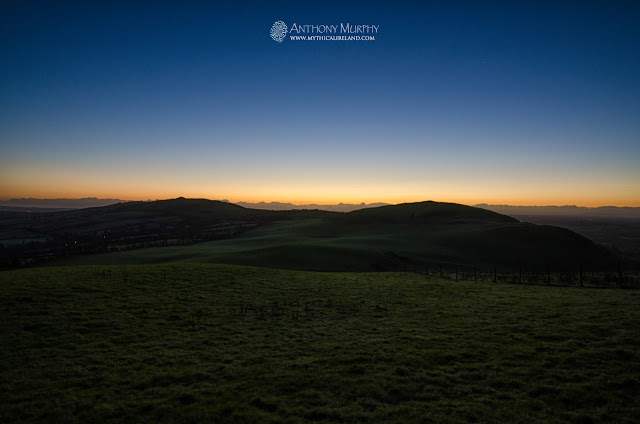
Carrigbrack hill at Loughcrew is also called Sliabh Rua (red mountain) and now I might know why...
 |
| Samhain sunrise over Sliabh Rua viewed from Cairn L on Carnbane West. |
When the sun rises at dawn on the ancient festival known as Samhain, the halfway point in days between autumn equinox and winter solstice, the sun rises out of the breast of Sliabh Rua and immediately its light shines into the chamber of Cairn L on Carnbane West. Its light dramatically strikes a bright, slender limestone pillar in the chamber. Standing outside the cairn, looking at the dawn sky, one cannot help but look and see Carnbane East (topped by Cairn T) and Sliabh Rua (topped by the remains of an old cairn) as the breasts of the hag.
This evening, I went back to Loughcrew. This time, I went to Slieve na Calliagh (Carnbane East) to see if I could determine where the sun goes down on Samhain as viewed from the Hag's Cairn (Cairn T). To my delight, it was a beautiful evening and the sun and sky put on a dazzling show for my camera. And as it sank down towards the horizon, I could see that the sun was setting over Sliabh Rua/Carrigbrack. It was easy to see from the resulting light show how that hill might have got its name - red mountain.
 |
| Samhain sunset over Sliabh Rua viewed from Slieve na Calliagh near Cairn T. |
 |
| The sun sinks behind Carrigbrack viewed from Slieve na Calliagh. |
Just to reiterate - at dawn on Samhain, the sun rises out of Red Mountain when one is situated at Cairn L, which is one of the largest cairns in the whole complex, and which has a chamber that faces towards Carrigbrack. At dusk, the sun sinks into Red Mountain when one is situated at Cairn T, also one of the largest cairns, known as the Hag's Cairn.
I've put together a simple map to show the alignments. It's based on imagery from Bing Maps, which has much clearer views of the Loughcrew landscape than Google Maps.
One of the fascinating things about the Samhain alignments is that the hag in other parts of Ireland is sometimes characterised as the Hag of Winter. The November cross-quarter date appears to have been important in pre-Christian times, although there is some debate about its true antiquity, and whether it was considered important in the Neolithic. Samhain was said to have marked the beginning of winter, or the beginning of the "dark half" of the year (the bright half beginning at Bealtaine in early May). Samhain was considered the principal festival in the ancient calendar.
Moreover, the visual aspect of the alignment system at Loughcrew leaves one in little doubt that the placement of cairns was set out with deliberate alignment in mind. With good weather for both Saturday's sunrise observation and this evening's sunset, I can certainly say that both events are very dramatic, and awe-inspiring. As stated in Saturday's blog post, the view from Cairn L towards Slieve na Calliagh and Carrigbrack certainly presents the impression of recumbent female breasts. This is a feature noted in Sligo, where the Ballygawley Mountains present the form of a recumbent pregnant female.(1)
 |
| A Samhain pre-dawn view of the breasts of the Cailleach from Cairn L on Carnbane West. |
It's worth noting too that the hill over which the sun rises on winter solstice when it shines into Newgrange in the Brú na Bóinne complex is also called Red Mountain.
*The four hills of Loughcrew are Carnbane (better known today as Carnbane West), Carrigbrack (Sliabh Rua), Slieve na Calliagh (better known today as Carnbane East) and Patrickstown Hill (the ancient name of which has been lost). In some versions of the creation myth, the Cailleach is said to have jumped on three hills, dropping stones from her apron, and in these versions it would appear Sliabh Rua is omitted. It's not clear why this is. In an old poem, in which the Cailleach is called the Garvoge, the hills are called Carnmore, Loar and Carnbeg.
References:
(1) http://intarch.ac.uk/journal/issue32/3/7.html

